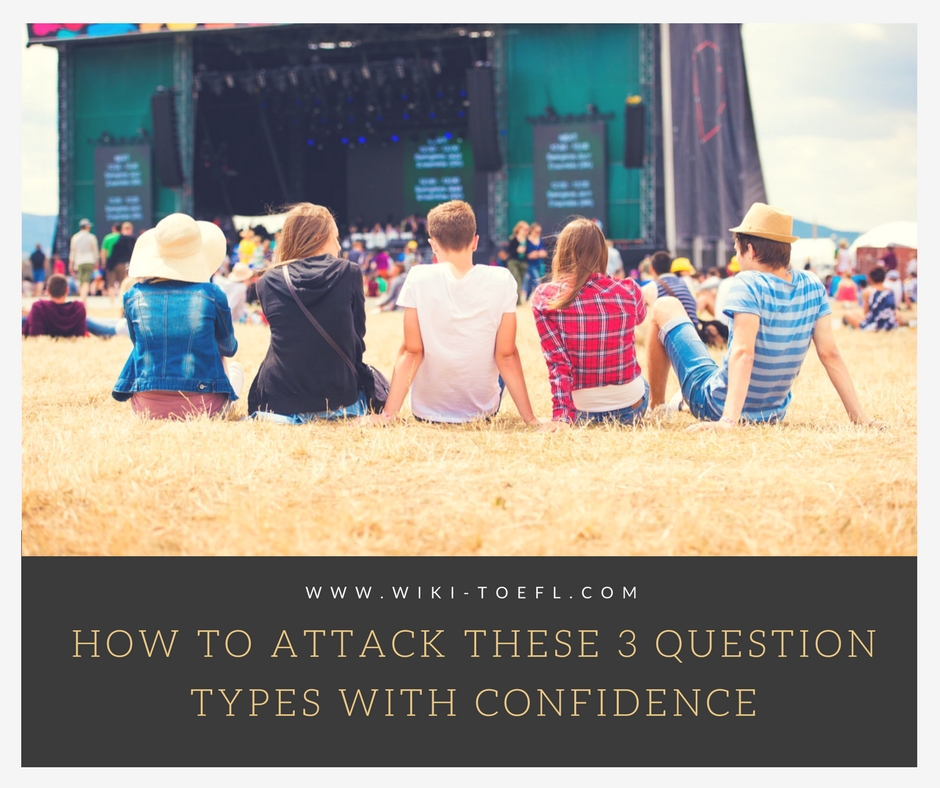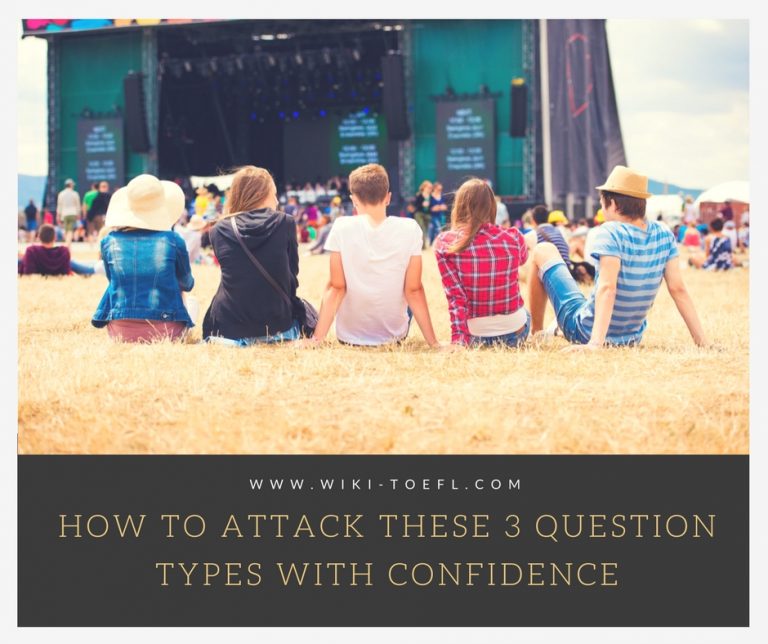You’ve studied hard for the TOEFL, using every resource you could find.
You’ve had a good night’s sleep and a good breakfast.
Then, the test begins.
You read the first question and…you aren’t sure of the answer.
Panic!
Is it possible to still answer the question correctly?
Believe it or not, you can!
I’m not talking about a lucky guess or a glance at your neighbor’s test.
All you need is a strong understanding of the three main question types on the TOEFL Reading section.
If you have this understanding, you’ll have the confidence to get through the test with success and ease.
Breaking Apart the TOEFL Reading Section: The 3 Question Types You Need to Know

So, what should you do if you aren’t sure of an answer?
1. Take a deep breath, and see if you can identify the question type.
2. Use simple strategies to help you make the best guess.
In total, there are ten specific types of questions on the TOEFL Reading section, which you can see examples of here. But if you’re able to identify and understand how to answer just the main three types, your confidence will increase along with your test scores.
Of course, the first thing to do is to read the passage. Plan to spend about 20 minutes on each of the three passages. Don’t forget to use reading strategies for comprehension and speed.
Then, it’s question and answer time! Let’s learn how to recognize the three major question types on the Reading section of the TOEFL.
1. Factual Questions
The best thing about factual questions is that the answer is right in the passage.
Here, the TOEFL is testing your ability to answer a question that the author of the passage has already answered for you. Kind of awesome, right? Of course, it’s not quite as easy as it seems!
Factual questions are, at least, easy to identify. They will ask you to look back at a specific part of the reading passage.
For example, the question will read:
“According to the passage, what is X?”
Or:
“In paragraph 2, what does the author say about Y?”
First, read the question carefully. Highlight or underline any key (important) words contained in the question. Try your best to understand what the question is asking.
Most likely, it will be a “W/H” question, asking one of the following:
- Who?
- What?
- Where?
- When?
- Why?
- How?
Quickly skim (search through) your passage for the key words in the question. Identify where the answer is written in the passage.
Now that you found the correct place in the passage, all that’s left is to select the right answer!
You’d think this would be easy. But those tricky TOEFL writers will do their best to trip you up.
Things to keep in mind:
- Read each answer choice carefully. Often, one or more of the answer choices will change the relationship between the key words. You’ll be able to eliminate it quickly.
- Be on the lookout for at least one answer choice that isn’t in the passage at all! That makes it easy on you: Eliminate that answer choice, too.
Hopefully, you’ll be left with an answer that answers your question. On to the next question!
2. Inference Questions
Next, it’s time to learn about inference questions. When you make an inference, you take the facts from the passage and use your own thoughts to come to a reasonable conclusion.
It’s like deciding not to drink spoiled (bad) milk. You catch a smell that makes your nose wrinkle. That smell is the fact. Using your previous knowledge, you make an educated guess that the milk has gone sour. That guess is the inference!
The author will imply (strongly hint at something in the text), which helps the reader make the inference (reasonable conclusion). The TOEFL writers consider how the implication (hint) should lead to the inference when they ask questions. This means that you’re already on your way to the right answer!
However, the answers to inference questions will not be found directly in the text. For these questions, you are asked to use a detail within the passage to come to a conclusion. Sound challenging? Never fear! Your knowledge of question types will help you select the correct answer.
You can recognize inference questions when you see words like “imply,” “infer” or “suggest” in the question.
Or, the question might ask about a “cause and effect.”
For example, the question will read:
“Which of the following can be inferred about X?”
Or:
“What is the author trying to imply about Y?”
First, read the question and the answer choices carefully. As you are reading, underline key words in both the question and the answer choices.
Next, check out the words that you underlined. You’ll see some synonyms(or different words with the same meaning) in the question and the answer choices.
For example, you might see the word “dangerous” in the question, and the word “unsafe” in an answer choice. Test writers use synonyms to ensure that you understand the concepts being discussed, or relationships between the words.
Be careful if you see the exact same words used in both the question and the answer. For example, if “dangerous” was used in both the question and the answer choice. Check the relationship between the words to see if the meaning has been changed.
Next, it’s time to make your inference.
Things to keep in mind:
- The TOEFL writers aren’t going to ask you to make a giant conclusion or inference. They know that you aren’t a scientist conducting an experiment! So, make sure that the answer choice you select is very closely related to what the question is asking.
- Be on the lookout for answer choices that change the meaning of details within the passage. Usually, you can eliminate at least one answer choice that contradicts (goes against) the passage.
After you eliminate some of these wrong answers, hopefully you’ll be able to select the right answer!
The correct answer will be one that makes a small, logical conclusion (often using synonyms) from the detail in the question.
Are you feeling like a TOEFL pro yet? There’s one more main question type.
3. Summary Questions
The last main question type to learn about is summary questions. These questions are special, because they ask you to recognize the most important ideas within the passage. Don’t worry: You’ve got this!
These questions may take a few different forms. They may ask you to:
- Summarize the passage.
- Add in a detail in the correct part of the passage.
- Group main ideas and details into a table.
Here, the TOEFL is testing your ability to look at a passage and select the most important information.
For example, the question may read:
“Which of the following summarizes the essential information from the text?”
Or:
“Where would this sentence best fit within the passage?”
Your first mission (task) is to understand the most important idea (or ideas) in the passage. If you can do this, you’re well on your way to answering the question correctly!
After reading, take a second look at the beginning and the end of the passage. Do you see any ideas or concepts repeated? Authors usually start and finish with the most important idea in their passage.
Next, identify the supporting details. Supporting details are details that will help you to understand or believe the main idea. Some supporting details will be more important than others.
Now that you’ve outlined (identified the main parts of) the passage, it’s time to answer the questions.
Things to keep in mind:
- Beware of answer choices that leave out important information from the passage.
- Again, you might see some answer choices that include information that isn’t in the passage at all! Make it easy on yourself and cross those answer choices out right away.
The correct answer will contain the most information that is in the passage, with supporting details organized according to how important they are.
Here’s the real trick behind learning the question types: It gives you confidence, even when you see vocabulary that you don’t recognize.
Remember, you aren’t going to understand each and every word that you encounter (come across) in the TOEFL Reading section. Don’t let that trip you up! Stay cool, calm and collected.
Instead of giving in to panic that will affect your ability to answer the questions that you do know, attack unknown questions with confidence.
Think about the question types and the strategies you’ve learned.
Eliminate answer choices.
Then, make your best guess.

